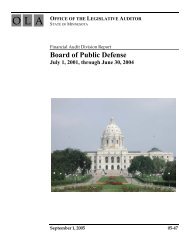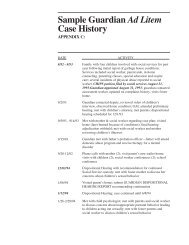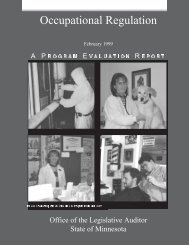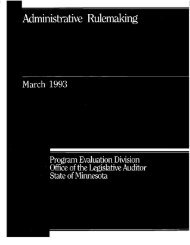Full Report (PDF) - Office of the Legislative Auditor
Full Report (PDF) - Office of the Legislative Auditor
Full Report (PDF) - Office of the Legislative Auditor
- No tags were found...
Create successful ePaper yourself
Turn your PDF publications into a flip-book with our unique Google optimized e-Paper software.
32MOTOR VEmCLE DEPUTY REGISTRARSin 1993, <strong>the</strong> number <strong>of</strong> motor vehicle transactions ranged from a low <strong>of</strong>258,000in February to a high <strong>of</strong> 526,000 in April. The Department <strong>of</strong> Public Safety staggersregistration due dates for automobiles, passenger vans, and light trucks fromMarch through December, and sets March 1st as <strong>the</strong> due date for renewing <strong>the</strong> registration<strong>of</strong> trucks, motorcycles, and trailers. However, vehicle registrations do nothave to be renewed until <strong>the</strong> vehicle is used. As a result, many people wait untilspring to renew seasonal vehicles, such as boat trailers.Transaction volume also varies from day to day. RegistIation renewals are due at<strong>the</strong> end <strong>of</strong> <strong>the</strong> month, though <strong>the</strong>re is a ten day grace period. Many deputy registIarsobserved that <strong>the</strong> busiest days tend to be <strong>the</strong> first ten days <strong>of</strong> <strong>the</strong> month and<strong>the</strong> days at <strong>the</strong> end <strong>of</strong> <strong>the</strong> month.Our samplereflects waitingtimes during<strong>the</strong> busy half <strong>of</strong>three"average"months.We made 205 visits to deputy registrars between July 29 and October II, 1993.As a result, our observation period does not include <strong>the</strong> busiest season (spring),nor <strong>the</strong> slowest season (winter, particularly February). We made about 80 percent<strong>of</strong> our visits during <strong>the</strong> last two business days <strong>of</strong> <strong>the</strong> month or <strong>the</strong> first ten days <strong>of</strong><strong>the</strong> month. Thus, our sample reflects waiting times during <strong>the</strong> busy half <strong>of</strong> three"average" months.We visited 86 deputy registmrs, including all 41 deputy registmrs in <strong>the</strong> Twin Citiesmetropolitan area and 45 deputies outside <strong>the</strong> metropolitan area. To save traveltime, we made about 90 percent <strong>of</strong> our trips within 75 miles <strong>of</strong> St. Paul, an areathat includes Rochester, Mankato, and St. Cloud. For deputy registmrs in <strong>the</strong>Twin Cities metropolitan area, we made at least two visits, usually three. We visitedall <strong>of</strong> <strong>the</strong> large deputy registrars in <strong>the</strong> state and most <strong>of</strong> <strong>the</strong> medium-largedeputies. Since deputies in <strong>the</strong> Twin Cities area are larger than deputies in <strong>the</strong> rest<strong>of</strong> <strong>the</strong> state, waiting times found in our sample may not reflect average waitingtimes in <strong>the</strong> state. As a result, we grouped visits by size <strong>of</strong> deputy (annual averagenumber <strong>of</strong> transactions), and type (public or private). To estimate state averages,we weighted group averages in proportion to <strong>the</strong>ir frequency in <strong>the</strong> state ra<strong>the</strong>rthan <strong>the</strong>ir frequency in our sample. Thus, unless waiting times for deputies outside<strong>the</strong> Twin Cities area are significantly different from deputies <strong>of</strong> <strong>the</strong> same sizethat are near <strong>the</strong> Twin Cities area, our sample should reflect state averages. Interviewswith DPS field representatives indicate that small deputies rarely have longwaiting times throughout <strong>the</strong> state, which is consistent with our findings for smalldeputies in our sample.Overall, we found that:• Most people received prompt service from deputy registrars.The averagewaiting timewas about 4.2minutes.During <strong>the</strong> time period we studied, about half <strong>of</strong> <strong>the</strong> walk-in customers waited oneminute or less, and 76 percent waited less than 5 minutes. The average waitingtime was about 4.2 minutes.Waiting time varied from 0 to 60 minutes during our visits. Overall, 14 percent <strong>of</strong>deputy registrar customers waited at least 10 minutes, 7 percent waited at least 20minutes, and 2 percent waited 30 minutes or longer.








